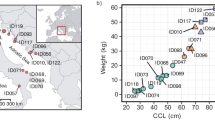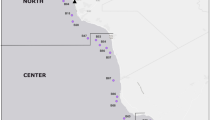Abstract
Some of microorganisms identified in cave ecosystems have been reported to play a permanent and strategic role for maintaining life of these environments. Human entrance into caves can induce some changes of cave physicochemical parameters which ultimately impacts the living organisms. In these facts, for the first time, Morca Cave was explored in a purpose to evaluate the impacts that can be caused by the human activities on microbial diversity in a limited period of time. Morca is a karts cave located in the Taşeli Plateau in the Middle Taurus mountains in Turkey. The first entrance into this cave was in 2018, and expeditors reached to − 500 m. During the second expedition in 2019, a camp was established at the − 1040-m depth during 4 days. In order to evaluate the human impacts in a new explored cave, this camping depth is chosen to be our studied area because it was its first entrance. Before the installation and at the end of the camp, sediments and surface samples were taken from different points of the camp area and around. Sequencing of 16 s rRNA of each sample to isolate DNA by using the next-generation sequencing (NGS) method was performed. The profile of the microbial diversity before the camping revealed that the class Thermoplasmata was dominated the archaea group and Gammaproteobacteria and Alphaproteobacteria were the most dominant bacterial classes. After the camp, most studied sites were noted with a decrease of microbial diversity especially the previous cited classes strains. Bacteria belonging to Bacilli class have increased after the camp. Increase of bacteria that are belonging to Bacteroidia has also observed in the most active areas. This present study highlight how cave microbial diversity can respond to the human activities within a short period inside a closed cave. Furthermore, it may constitute a solid basis and support on the improvement of techniques for cave management and expedition planning for the conservation of cave nature.







Similar content being viewed by others
Data availability
The generated raw sequencing data of the 12 studied samples were deposited into the NCBI database under these accession numbers: SAMN18256317-28.
References
Alonso L, Pommier T, Kaufmann B, Dubost A, Chapulliot D, Doré J, Douady CJ, Moënne-Loccoz Y (2019) Anthropization level of Lascaux Cave microbiome shown by regional-scale comparisons of pristine and anthropized caves. Mol Ecol 28:3383–3394. https://doi.org/10.1111/mec.15144
Banerjee S, Jha DK, Joshi SR (2019) Cave microbiome for human welfare. In: Satyanarayana T, Das T, Jhori B (Eds), Microbial diversity in ecosystem sustainability and biotechnological applications. Springer, Singapore, pp 3–30. https://doi.org/10.1007/978-981-13-8487-5_1
Barton HA (2006) Introduction to cave microbiology: a review for the non-specialist. J Caves Karst Stud 68:43–54. https://doi.org/10.1007/978-981-13-8487-5_1
Barton HA, Hershey OS (2019) The microbial diversity of caves. In: O’ Moldovan, LK, Halse S (Eds) Cave Ecology. Springer, Cham, pp 69–90. https://doi.org/10.1007/978-3-319-98852-8_5
Barton HA, Jurado V, (2007) What’s up down there? Microbial diversity in caves, Microbiome 2:132–138. http://hdl.handle.net/10261/61951
Baskaran V, Patil PK, Antony ML, Avunje S, Nagaraju VT, Ghate SD, Nathamuni S, Dineshkumar N, Alavandi SV, Vijayan KK (2020) Microbial community profiling of ammonia and nitrite oxidizing bacterial enrichments from brackish water ecosystems for mitigating nitrogen species. Sci Rep 10:1–11. https://doi.org/10.1038/s41598-020-62183-9
Bendia AG, Callefo F, Araújo MN, Sanchez E, Teixeira VC, Vasconcelos A, Battilani G, Pellizari VH, Rodrigues F, Galante D (2020) Metagenome-assembled genomes from Monte Cristo Cave (Diamantina, Brazil) reveal prokaryotic lineages as functional models for life on Mars. bioRxiv 185041
Bendia AG, Callefo F, Araújo MN, Sanchez E, Teixeira VC, Vasconcelos A, Battilani G, Pellizari VH, Rodrigues F, Galante D (2022) Metagenome-assembled genomes from Monte Cristo Cave (Diamantina, Brazil) reveal prokaryotic lineages as functional models for life on Mars. Astrobiology 22(3):293–312. https://doi.org/10.1101/2020.07.02.185041
Bercea S, Nastase-Bucur R, Moldovan OT, Kenesz M, Constantin S (2019) Yearly microbial cycle of human exposed surfaces in show caves. Subterr Biol 31:1–14. https://doi.org/10.3897/subtbiol.31.34490
Borrel G, Parisot N, Harris HM, Peyretaillade E, Gaci N, Tottey W, Brugère JF (2014) Comparative genomics highlights the unique biology of Methanomassiliicoccales, a Thermoplasmatales-related seventh order of methanogenic archaea that encodes pyrrolysine. BMC Genom 15:1–24. https://doi.org/10.1186/1471-2164-15-679
Çandıroğlu B, Doğruöz Güngör N (2020) The biotechnological potentials of bacteria isolated from Parsık Cave. Turkey, Johnson Matthey Technol Rev 64:466–479. https://doi.org/10.1595/205651320X15923194903811
de Marques ELS, Gross E, Dias JCT, Pirovani CP, Rezende RP (2018) Ammonia oxidation (amoA) and nitrogen fixation (nifH) genes along metasandstone and limestone caves of Brazil. Geomicrobiol J 35:869–878. https://doi.org/10.1080/01490451.2018.1482386
Doğruöz-Güngör N (2020) The microbial community structure of the Dupnisa cave in Kırklareli, Turkey. Acta Carsologica 49:2–3. https://doi.org/10.3986/ac.v49i2-3.8575
Dong Y, Gao J, Wu Q, Ai Y, Huang Y, Wei W, Weng Q (2020) Co-occurrence pattern and function prediction of bacterial community in Karst cave. BMC Genom 20:1–13. https://doi.org/10.1186/s12866-020-01806-7
Evans PN, Boyd JA, Leu AO, Woodcroft BJ, Parks DH, Hugenholtz P, Tyson GW (2019) An evolving view of methane metabolism in the Archaea. Nat Rev Microbiol 17:219–232. https://doi.org/10.1038/s41579-018-0136-7
Fang BZ, Han MX, Jiao JY, Zhang XT, Xie YG, Hozzein WN, Alkhalifah DHM, Xiao M, Li WJ (2019) Nocardioides speluncae sp. nov., a novel actinobacterium isolated from a karstic subterranean environment sample. Antonie Van Leeuwenhoek 112:857–865. https://doi.org/10.1007/s10482-018-01217-9
Gan HM, Wengert P, Barton HA, Hudson AO, Savka MA (2020) Insight into the resistome and quorum sensing system of a divergent Acinetobacter pittii isolate from an untouched site of the Lechuguilla Cave. Access Microbiol. https://doi.org/10.1099/acmi.0.000089
Ghosha S, Kuisieneb N, Cheepthama N (2017) Review: The cave microbiome as a source for drug discovery: reality or pipe dream. Biochem Pharmacol 134:18–34. https://doi.org/10.1016/j.bcp.2016.11.018
Groth I, Vettermann R, Schuetze B, Schumann P, Saiz-Jimenez C (1999) Actinomycetes in Karstic caves of Northern Spain (Altamira and Tito Bustillo). J Microbiol Meth 36:115–122. https://doi.org/10.1016/S0167-7012(99)00016-0
Han MX, Fang BZ, Tian Y, Zhang WQ, Jiao JY, Liu L, Zhang ZT, Xiao M, Wei DQ, Li WJ (2017) Nocardioides cavernae sp. nov., an actinobacterium isolated from a karst cave. Int J Syst Evol Microbiol 67:633–639. https://doi.org/10.1099/ijsem.0.001676
Ikner LA, Toomey RS, Nolan G, Neilson JW, Pryor BM, Maier RM (2007) Culturable microbial diversity and the impact of tourism in Kartchner Caverns, Arizona. Microb Ecol 53:30–42. https://doi.org/10.1007/s00248-006-9135-8
Jurado V, Gonzalez-Pimentel JL, Miller AZ, Hermosin B, D’Angeli IM, Tognini P, Saiz-Jimenez C (2020) Microbial communities in vermiculation deposits from an Alpine cave. Front Earth Sci 8:635. https://doi.org/10.3389/feart.2020.586248
Kimble JC, Winter AS, Spilde MN, Sinsabaugh1 RL, Northup DE (2018) A potential central role of Thaumarchaeota in N-cycling in a semi-arid environment, Fort Stanton Cave, Snowy River passage, FEMS Microbiol. Ecol 94:fiy173. https://doi.org/10.1093/femsec/fiy173
Kukla J, Holec M, Trögl J, Holcová D, Hofmanová D, Kuráň P, Honzík R (2018) Tourist traffic significantly affects microbial communities of sandstone cave sediments in the protected landscape area “Labské Pískovce”(Czech Republic): implications for regulatory measures, sustain 10 (2): 396 https://doi.org/10.3390/su10020396
Kurniawan ID, Rahmadi C, Ardi TE, Nasrullah R, Willyanto MI, Rahayu S (2017) The detection of human activities’ impact on show caves environment in Pacitan, Indonesia, In: Proc 17th Int Congr Speleol. Sydney, pp 175–8
Lavoie KH, Northup DE (2006) Bacteria as indicators of human impact in Caves. In: Proceedings of the 17th National Cave and Karst Management Symposium, pp 44–47
Lee JM, Jin CZ, Park SH, Kang MK, Park DJ, Kim CJ (2021) Nocardioides antri sp. nov., Isolated from Soil in a Rock Cave. Curr Microbiol 78:2130–2135. https://doi.org/10.1007/s00284-021-02370-7
Leuko S, Koskienen K, Sanna L, D’Angeli IM, Wael DJ, Marcia P, Rettberg CMEP (2017) The influence of human exploration on the microbial community structure and ammonia oxidizing potential of the Su Bentu limestone cave in Sardinia. Italy Plos One 12:e180700. https://doi.org/10.1371/journal.pone.0180700
Li Y, Kawamura Y, Fujiwara N, Naka T, Liu H, Huang X, Ezaki T (2004) Sphingomonas yabuuchiae sp. nov. and Brevundimonas nasdae sp. nov., isolated from the Russian space laboratory Mir. Int J Syst Evol Microbiol 54:819–825. https://doi.org/10.1099/ijs.0.02829-0
Mazina SE, Titov AY, Kozlova EV, Popkova AV (2020) Microbiota of aquatic and terrestrial habitats of the Dzou Cave. IOP Conf. Ser. Earth Environ Sci 690. https://iopscience.iop.org/article/https://doi.org/10.1088/1755-1315/690/1/012032/meta 012032
Mengmeng L, Chaolin F, Satoru K, Minsheng H, Vaenyam A (2019) Bio-consolidation of cracks in masonry cement mortars by Acinetobacter sp. SC4 isolated from a karst cave. Int Biodeterior Biodegrad 141:94–100. https://doi.org/10.1016/j.ibiod.2018.03.008
Parada AE, Needham DM, Fuhrman JA (2016) Every base matters: assessing small subunit rRNA primers for marine microbiomes with mock communities, time series and global field samples. Environ Microbiol 18(5):1403–1414. https://doi.org/10.1111/1462-2920.13023
Rasigraf O, Kool DM, Jetten MSM, Damsté JSS, Ettwiga KF (2014) Autotrophic carbon dioxide fixation via the Calvin-Benson-Bassham Cycle by the denitrifying methanotroph “Candidatus Methylomirabilis oxyfera.” Appl Environ Microbiol 80:2451–2460. https://doi.org/10.1128/AEM.04199-13
Rusznyák A, Akob DM, Nietzsche S, Eusterhues K, Totsche KU, Neu TR, Küsel K (2012) Calcite biomineralization by bacterial isolates from the recently discovered pristine karstic Herrenberg cave. Appl Environ Microbiol 78:1157–1167. https://doi.org/10.1128/AEM.06568-11
Sar P, Dutta A, Bose H, Mandal S, Kazy SK (2019) Deep biosphere: microbiome of the deep terrestrial subsurface. In: Satyanarayana T, Das S, Jhori B (Eds) Microbial biodiversity in ecosystem sustainability and biotechnological applications. Springer, Singapore, pp 225–265. https://doi.org/10.1007/978-981-13-8315-1_8
Su Z, Dai T, Tang Y, Huang B, Mu Q, Wen D (2018) Sediment bacterial community structures and their predicted functions implied the impacts from natural processes and anthropogenic activities in coastal area. Mar Pollut Bull 131:481–495. https://doi.org/10.1016/j.marpolbul.2018.04.052
Tomczyk-Zak K, Zielenkiewicz U (2016) Microbial diversity in caves. Geomicrobiol J 33:20–38
Türkgenci MD, Doğruöz-Güngör N (2021) Profiling of bacteria capable of precipitating CaCO3 on the speleothem surfaces in Dupnisa Cave, Kırklareli, Turkey. Geomicrobiol J 38:816–827. https://doi.org/10.1080/01490451.2021.1964110
Urzì C, Leo FD, Bruno L, Albertano P (2010) Microbial diversity in Paleolithic caves: a study case on the phototrophic biofilms of the Cave of Bats (Zuheros, Spain). Microb Ecol 60:116–129. https://doi.org/10.1007/s00248-010-9710-x.pdf
Usuloğlu AE (2019) Morca 2019. pdf report from Anadolu Speology Grup Derneği (Anatolian Speleological Society)
Usuloğlu AE (2020) The Morca Cave System 2020 expedition report. pdf from Anadolu Speology Grup Derneği (Anatolian Speleological Society)
Walters W, Hyde ER, Berg-Lyons G, Ackermann G, Humphrey G, Parada A, Gilbert JA, Jansson JK, Caporaso JG, Furhman JA, Apprill A, Knight R (2015) Improved bacterial 16S rRNA gene (V4 and V4–5) and fungal internal transcribed spacer marker gene primers for microbial community surveys. mSystems 1. e00009–15 https://doi.org/10.1128/mSystems.00009-15
Wang H, Bier R, Zgleszewski L, Peipoch M, Omondi E, Mukherjee A, Kan J (2020) Distinct distribution of Archaea from soil to freshwater to estuary: implications of archaeal composition and function in different environments. Front Microbiol 11. https://doi.org/10.3389/fmicb.2020.576661
Wéry N, Monteil C, Pourcher AM, Godon JJ (2010) Human-specific fecal bacteria in wastewater treatment plant effluents. Water Res 44:1873–18883. https://doi.org/10.1016/j.watres.2009.11.027
White WB, Culver DC (2009) Cave, definition of. In: White WB and Culver DC (eds) The encyclopedia of caves. Academic Press. pp 255–259. https://doi.org/10.1016/B978-0-12-814124-3.00028-5
Yoon HJ, Cho YG, Lee ST, Suzuki I, Nakase T, Park YH (1999) Nocardioides nitrophenolicus sp. nov., a p-nitrophenol-degrading bacterium. Int J Syst Evol Microbiol 49:675–680. https://doi.org/10.1099/00207713-49-2-675
Zhao R, Wang H, Yang H, Yun Y, Barton HA (2017) Ammonia-oxidizing Archaea dominate ammonia-oxidizing communities within alkaline cave sediments. Geomicrobiol J 34:511–523. https://doi.org/10.1080/01490451.2016.1225861
Zhu HZ, Zhang ZF, Zhou N, Jiang CY, Wang BJ, Cai L, Liu SJ (2019) Diversity, distribution and co-occurrence patterns of bacterial communities in a karst cave system. Front Microbiol 10. https://doi.org/10.3389/fmicb.2019.01726,1726
Funding
This research was financially supported by the Scientific Research Projects Unit of Istanbul University (Bilimsel Araştirma Projeleri Birimi, Istanbul Üniversitesi) under the Project number: 35041.
Author information
Authors and Affiliations
Corresponding author
Ethics declarations
Conflict of interest
The authors declare no competing interests.
Additional information
Publisher's note
Springer Nature remains neutral with regard to jurisdictional claims in published maps and institutional affiliations.
Supplementary Information
Below is the link to the electronic supplementary material.
Rights and permissions
Springer Nature or its licensor (e.g. a society or other partner) holds exclusive rights to this article under a publishing agreement with the author(s) or other rightsholder(s); author self-archiving of the accepted manuscript version of this article is solely governed by the terms of such publishing agreement and applicable law.
About this article
Cite this article
Ahamada Rachid, N., Doğruöz Güngör, N. Major impacts of caving activities on cave microbial diversity: case study of Morca Cave, Turkey. Int Microbiol 26, 179–190 (2023). https://doi.org/10.1007/s10123-022-00287-0
Received:
Revised:
Accepted:
Published:
Issue Date:
DOI: https://doi.org/10.1007/s10123-022-00287-0




